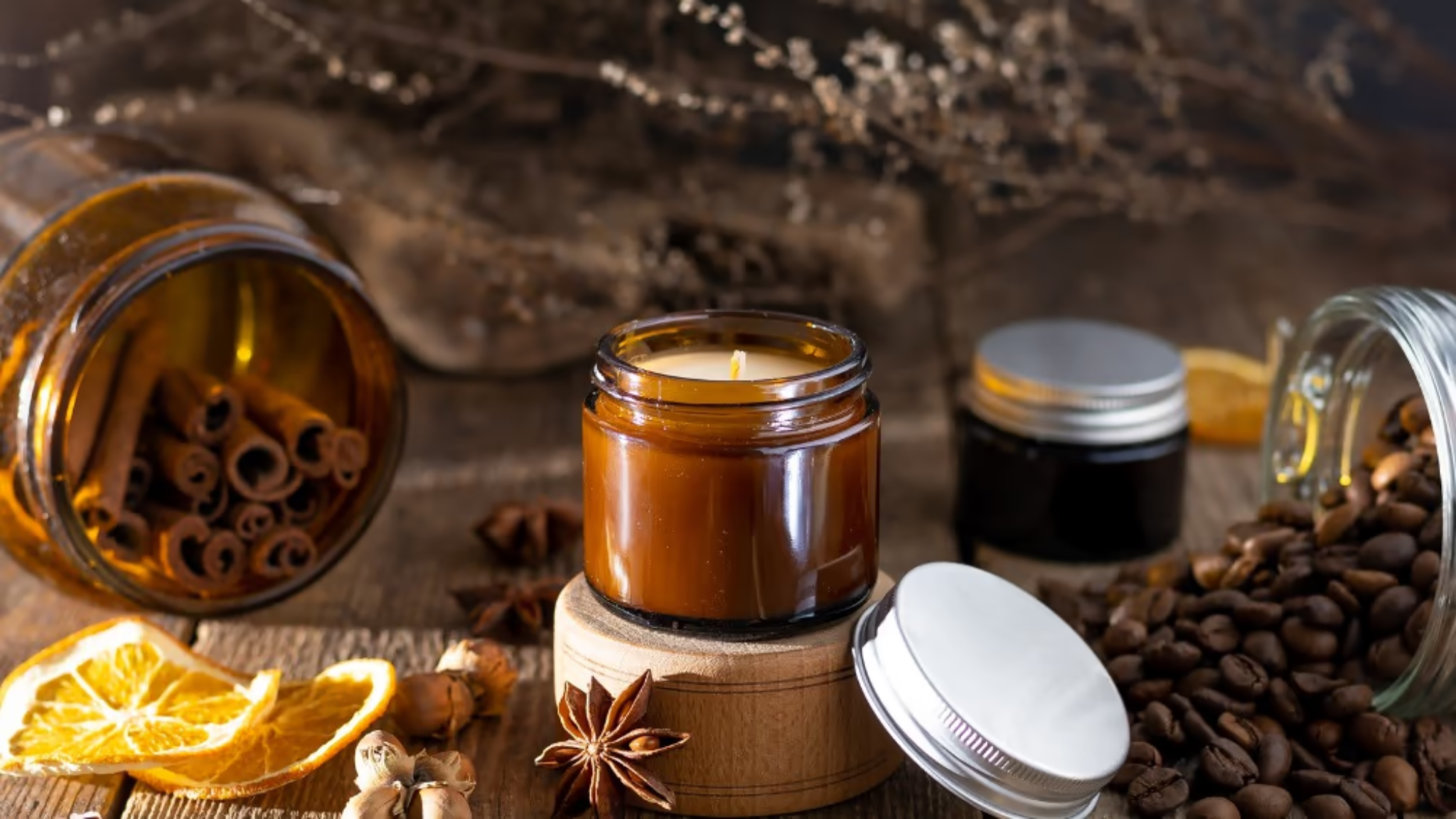Coffee scented candles promise the rich smell of fresh coffee but rarely deliver on that promise. The story starts with French perfumer Pierre-Francois Lubin’s first coffee-vanilla-cinnamon blend in the 18th century. Today’s coffee candles fill homes and coffee shops everywhere, yet something crucial remains missing.
Most coffee candles fail to match real coffee’s authentic smell. Those decorative coffee beans you see in many candles? They look nice but add nothing to the scent. This guide shows you why regular coffee candles miss the mark and reveals the new methods finally bringing true coffee aromas to your home.
Coffee’s Complex Aroma Science

Coffee holds more than 800 different volatile compounds, putting it next to cheese, chocolate, and wine in aromatic complexity. Let’s break down what makes coffee smell like coffee.
Coffee’s 800 Aroma Building Blocks
Coffee gets its rich smell from chemical reactions during roasting. The main players? Maillard reactions between proteins and sugars, amino acids breaking down, trigonelline decomposing, and various chemical products mixing together. Scientists found furans lead the pack, followed by phenolic compounds, pyrazines, aldehydes, and ketones.
Coffee Scented Candles: Coffee Brewing Changes The Smell
Your coffee’s smell changes as it brews. Different compounds dissolve at their own pace based on their chemical structure. The buttery smell (from 2,3-butanedione) shows up first, while fruity notes (from β-damascenone) take more time to develop.
What Makes Fresh Coffee Smell Fresh
Fresh coffee’s signature smell comes from these key compounds:
- Furans: Give you those sweet caramel smells, especially when they mix with sulfur compounds
- Pyrazines: Create roasted, nutty scents and work with thiazoles to build coffee’s core smell
Sulfur compounds make a big difference too. One compound called 2-furfurylthiol creates that classic roasted coffee smell. Even methanethiol, which smells like cabbage by itself, adds important notes to coffee’s aroma.
The amount of each compound depends on the coffee variety, growing conditions, ripeness, and processing. Roasting transforms basic ingredients like carbohydrates, proteins, and acids into these aromatic compounds. This complex chemistry explains why making true coffee-scented candles proves so challenging.
Regular Coffee Candles Don’t Work – Here’s Why

Regular coffee-scented candles leave most buyers wanting more. The problems start with basic candle-making limits that stop these candles from smelling like real coffee.
Heat Ruins Coffee’s Best Smells
Coffee’s smell compounds break down easily with heat. Tests show damage starts at 130°C. Key compounds die even sooner – monochlorogenic acids at 114°C, dichlorogenic acids at 108°C, and caffeine at 146°C. Candle wax needs 180-185°F to hold fragrance. These high temperatures kill coffee’s natural smells.
Coffee Scented Candles: Fake Fragrances Fall Short
Artificial fragrances bring their own problems. One “fragrance” can pack up to 5,000 different ingredients. About 95% come from petroleum. Users often say these fake scents smell more like chemical chocolate than coffee.
Fragrance oils face three main issues:
- Wax only takes so much fragrance oil
- Too much oil separates from the wax
- The wrong temperature ruins the scent spread
Those Coffee Beans? Just For Show
Coffee beans sitting in candles look nice but do nothing for smell. Adding real coffee beans or grounds makes things worse – they burn and smell bad instead of creating a coffee scent.
The big problem? Coffee’s smell needs many compounds working together. Regular candle-making can’t keep these compounds stable at high temperatures. That’s why most coffee candles use fake scents that only hint at real coffee’s smell.
Coffee Candle Chemistry: The Core Problems
Coffee candles face tough chemistry challenges beyond simple smell copying. Let’s look at why natural coffee aromas fight against becoming candle scents.
Missing Middle Notes Make Bad Coffee Smells
Coffee packs over 1000 volatile compounds, but candle makers can’t recreate their complex dance. The middle notes – especially pyrazine and pyridine derivatives – make the coffee smell real. These compounds just won’t stay stable in candle wax.
The Truth About Artificial Coffee Scents
Temperature ruins coffee candle chemistry. Wrong temperatures when adding fragrance oils mess up the binding process. Wax needs 160°F to 185°F for proper binding, but these temperatures destroy coffee’s natural smell compounds.
TCoffee Scented Candles: Temperature Control Makes or Breaks Your Candle
Room conditions change how your candle performs. Here’s what matters:
- Hot rooms release more scent but burn through it faster
- Humidity changes how well candles burn
- Best results need 70°F rooms with 40-60% humidity
Scented wax releases more VOCs than regular candles. These compounds mix with ozone when nitrogen monoxide drops low. Too much heat makes fragrance oils vanish quickly, changing your coffee smell completely.
New cold plasma methods show promise – they cut down unwanted green smells while boosting chocolate notes. Still, getting all these smell compounds to work together perfectly remains tricky.
New Technology Makes Real Coffee Candles Possible

The latest fragrance methods unlock true coffee scents in candles. These methods capture coffee’s complex smell better than anything before.
Molecular Extraction Gets Real Coffee Scents
Head Space technology stands out as the game-changer for coffee candle scents. This method pulls out fragrances without solvents or preparation, keeping the original smells intact. Scientists capture scent molecules in glass flasks, and then use special tools to map out exact molecular patterns.
Cold-Capture Keeps Coffee Smells Fresh
Cold diffusion marks another big step forward. This method turns aroma oils into tiny vapor particles (1-3 microns) without heat or water. The result? Scents stay pure and last longer. Coffee’s sensitive smell compounds survive intact – something hot methods can’t achieve.
Tiny Capsules Lock-In Coffee Scents
Microencapsulation changes everything about coffee fragrance storage and release. Smell molecules get wrapped in microscopic protective shells. The process works in three ways:
- Natural biopolymer spray drying using gum arabic and maltodextrin
- Biodegradable coacervation methods
- Silica matrix trapping through sol-gel methods
Smart Release Keeps Scents Going
New time-release systems make coffee scents last. The process mixes fragrance oils with stabilizers. Special initiators then build protective walls around scent droplets, creating tiny capsules that release smell slowly.
Soy wax works best with these new methods, binding scents better and making less soot. Plus, new ways of adding real coffee compounds to wax show great results for authentic coffee aromas.
Real Coffee Candles Finally Work
Science solved the coffee candle puzzle. Old methods failed with coffee’s 800+ smell compounds. Now, Head Space technology and microencapsulation lock in these delicate scents perfectly.
Cold-capture fixes the heat problem that ruined old coffee candles. Time-release technology makes these scents last longer and smell more real than ever.
Coffee candle fans get better options every day. New methods like cold diffusion and advanced microencapsulation mean more candles that smell exactly like fresh coffee. Your home can now smell like your favorite coffee shop, thanks to these scientific breakthroughs.




